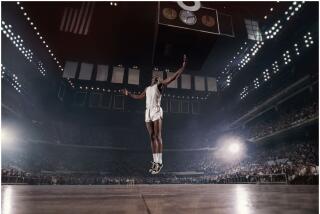First Class Study of Fischinger’s Impact
- Share via
Before there were Walt Disney and “Fantasia,” there were Oskar Fischinger and “Study No. 8.” Fischinger’s dazzlingly inventive animated short was one of several labor-intensive works that secured for him a position as a pioneer of avant-garde filmmaking.
For the first time, “Study No. 8” is now available on video, along with six other animated films the artist finished between 1927 and 1947. Seeing the film glow on the small screen is, of course, significantly different from seeing it projected big and in the dark; yet, video technology offers revealing possibilities for examination--slow-motion, stop-action, instant replay--all of which serve to make Fischinger’s achievement that much more amazing. Jack Rutberg Fine Arts, where the video was produced, is celebrating the release of Volume 1 of a planned series of videos with an exhibition of some 50 paintings and drawings from throughout Fischinger’s career.
Using the score of Paul Dukas’ “The Sorcerer’s Apprentice” as a soundtrack, the German-born Fischinger (1900-67) completed “Study No. 8” in 1931, five years before he fled Berlin for Los Angeles to escape the growing Nazi terror. Instead of Mickey Mouse and dancing broomsticks, which Disney served up so memorably six years later, Fischinger gave us a stunning corps de ballet composed of white light in geometric shapes, which twirled and swooped and cavorted in and out of a pitch-black visual field.
Disney’s version--memorably animated by James Nelson Agar, who died in February--is a terrific example of modern industrial art, emblematic of the best of the studio system in its heyday. The sequence was conceived as a short subject and mostly completed by 1938. But the expense of the animation process led to its subsequent inclusion as one episode in the longer, more elaborate extravaganza “Fantasia” (1940).
The studio’s aim was to create a compelling star vehicle for Mickey, an established animated character whose standing at the box office had begun to slip. Like many a live actor in a similar predicament, he was cast in a classic--here, Goethe’s story of a hapless magician’s assistant. With great stylishness and wit, “The Sorcerer’s Apprentice” successfully gave us Mickey--to borrow the parlance of the ad men--as we’d never seen him before.
Although the movie’s predecessor, “Study No. 8,” also combined film animation with the same piece of readily identifiable music by a serious composer, the German artist’s work couldn’t be more different. Rather than illustrate the music in a linear narrative, as Disney did, Fischinger created music’s visual equivalent. An aural abstraction was given visually abstract form. The “story” his movie tells is one of sight and sound.
The Disney segment is often discussed as a cautionary narrative for the budding nuclear age, one that warns of the dangers inherent in fiddling with the unknown. Actually, as mayhem breaks out at the office when the boss is away, it works as a much more mundane and restrictive metaphor for the perils of not knowing when to stay in your place.
*
By delightful contrast, Fischinger’s tale unfolds a giddy, liberating experience of space in four dimensions. In paintings such as 1939’s “Abstraction #651” and 1949’s “Blue Green Horizontals”--small canvases both formerly in the celebrated Los Angeles collection of Milton Wichner, and two of the most beautiful pictures in the Rutberg show--he used the vocabulary of nonobjective painting to create images that suggest the invisible worlds of the microbe and the galaxies, the infinitesimally small and the unimaginably gigantic. Film gave Fischinger the chance to add the dimension of time to the paintings’ mix.
Establishing an equivalence between abstract painting and music was central to the pioneering spirit of European and American nonobjective art, ever since its beginning in the teens. Arthur Dove, Piet Mondrian, Wassily Kandinsky and many other painters were fueled by faith in abstraction as a potentially universal language. They conceived of abstraction as a visual form akin to the sonorous tonalities of music. In such radiant Fischinger paintings as 1943’s “Untitled Abstraction,” in which a yellow orb anchored to a black bar seems to radiate light into a field of midnight blue, the kinship with Kandinsky is perhaps most strongly felt.
(Incidentally, if you want to see some terrific current art that owes something to Fischinger’s legacy, now is the time. Check out Jim Isermann’s sculpture at Richard Telles Fine Art, around the corner from Rutberg, and Jennifer Steinkamp’s computer-animated video installation at ACME Gallery.)
When Fischinger arrived in L.A. in 1936, he went to work first for Paramount, then for MGM, then for Disney (he was hired to work on the Toccata and Fugue segment of “Fantasia”), passing through them all with the speedy efficiency of a revolving door. By 1939, unable to reconcile the collaborative nature of American studio animation with his European Modernist idea of what it meant to be an artist, he’d mostly given up on Hollywood.
So, the story told by “Study No. 8” and the other eye-popping Fischinger films in the video is also a story of autonomy and individualism--of the artist as an independent creative force, alienated from the modern world of industrial mass production. Artistically, that condition is about as far as you can get from the Hollywood studio system.
* Jack Rutberg Fine Arts, 357 N. La Brea Ave., (213) 938-5222, through May 30. Videos available at the gallery, which will screen several Fischinger films and hold a discussion with Elfriede (Mrs. Oskar) Fischinger and animation film scholar William Moritz tonight at 8.
More to Read
The biggest entertainment stories
Get our big stories about Hollywood, film, television, music, arts, culture and more right in your inbox as soon as they publish.
You may occasionally receive promotional content from the Los Angeles Times.











